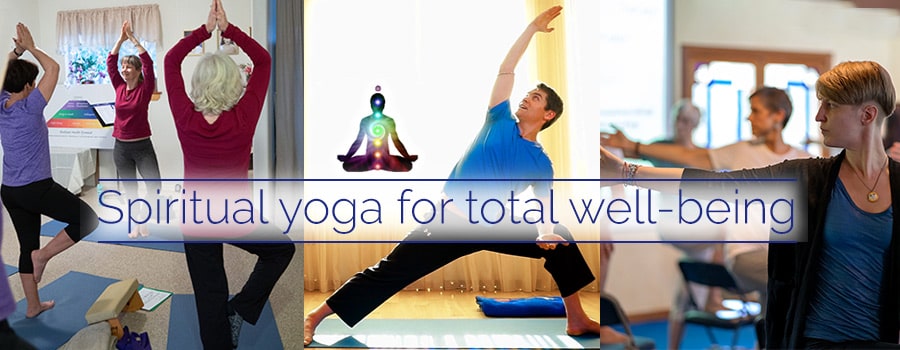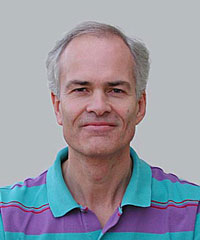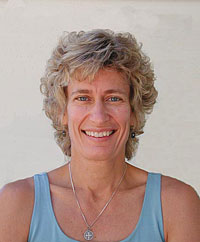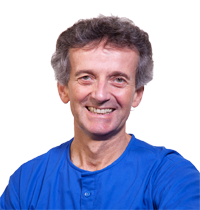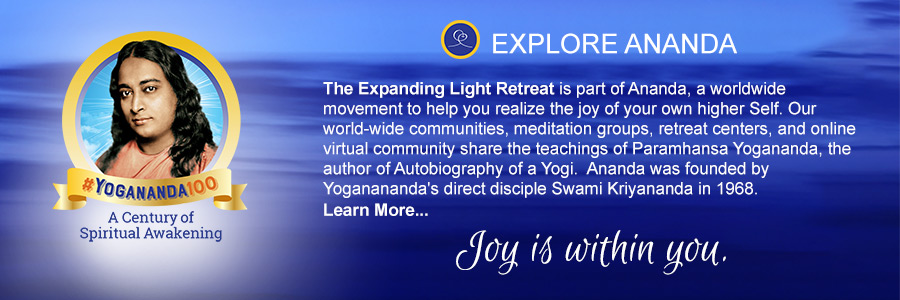|
This article was written for the Ananda Yoga® Teacher Association newsletter. Learn more, or find a certified Ananda Yoga® teacher near you. |
Engage Your Core?
Download PDF (1.65mb)
Unless you’ve been living in a cave for some years, you’ve heard yoga teachers telling their students, “Engage your core.” This didn’t happen until recently. My guess is that it arose from the popularity of Pilates classes (where “the core” is a key focus) — many yoga teachers simply decided to “import” into yoga some Pilates principles.
Although Pilates practice provides many benefits, its goals are quite different from those of classical Hatha Yoga. So it seems to me that many yoga teachers and students alike could benefit from a closer look at the instruction, “Engage your core,” as it applies to Hatha Yoga. That’s why I’ve dedicated this long article to an exploration of the core: what it is, what role it plays in daily life, and what role it might have in Ananda Yoga.
To give you both physical and energy-based perspectives, I interviewed a panel of four Ananda Yoga teachers with professional experience in working with the body:
- Barbara Bingham — Physical Therapist and Anatomy & Physiology teacher in Ananda Yoga Teacher Training
- Alan Williams — Osteopathic Physician and Pilates teacher
- Julie Bryant, D.C., Chiropractor
- Nicole DeAvilla, Ananda Yoga Therapy Teacher Training instructor, with additional background in sports medicine and chiropractic physiotherapy
I asked our panel to limit the scope of their answers to people with healthy bodies, since injuries and chronic problems/weaknesses bring up many complications. I think you’ll enjoy what all of them have to say — right down to your core.
Start with a Yogic Perspective
From an Ananda Yoga perspective, the true “core” is the astral spine. As Swami Kriyananda has often said, “that’s where the real spiritual work takes place.” And as you know, working with the body’s subtle energy, especially the energy of the astral spine, is what Ananda Yoga is about.
Still, the physical core is important — not only for physical health and function, but also because a straighter physical spine leads to a freer flow of energy in the astral spine. As Paramhansa Yogananda often said, “A bent spine is the enemy of self-realization.” This correlation is central to the higher levels of asana practice, pranayama and meditation, and below you’ll read how this comes up in reference to the (physical) core.
In terms of physical anatomy, there seems to be no such thing as the core; different people have different ideas as to what it is. As you’ll see, even the members of our panel make different choices of emphasis and terminology concerning the core. But I think all will become clear to you as they explain how they view the role of the core in everyday life, as well as in asana practice. There was a lot agreement, yet each person had some unique insights to share. Now let’s move through each panel member’s discussion of the core, one person at a time.
Barbara on the Role of the Core
Gyandev: What is the core?
Barbara: In general terms, it could be considered the trunk, that is, the pelvis and torso considered as a unit. The body can be loosely divided into two parts: the trunk and the limbs. I begin my thinking of the core of the body as the spinal column. (Remember, the neck and head are part of this as well.) The spinal column is firmly attached to the pelvis, so the movements of one structure affect the other. The muscles attached to the spinal column, pelvis, and ribs together form the trunk. The spine and trunk are built to move, but they’re also built to be stable.
When people speak of the core, they usually mean the “inner core” muscles of the trunk: diaphragm, pelvic floor, transverse abdominis and multifidus (see illustrations below). This inner core is concerned with stability, and its muscles work in harmony to create this stability. The other muscles are more concerned with movement, although it’s not always possible to strictly categorize a trunk muscle as being concerned with only stability or only movement. When all the muscles of the trunk work together harmoniously, we have good posture while static (meditating) or moving (everyday activities as well as asana practice).
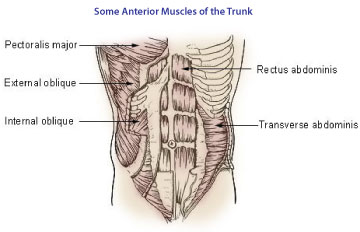
Gyandev: How would you put this in simplest terms?
Barbara: I think in terms of the spine and trunk, not “the core.” I focus on awareness of trunk posture and stability. From a functional standpoint, I include both pelvic stability and scapular stability in my vision of trunk stability.
I essentially look to enhance posture, which has physical and spiritual benefits. Drawing oneself up through the crown of the head helps to level the pelvis and lengthen the spine, reducing any excessive curvatures in the spine, reducing strain and compression of the joints and the bones. This allows for improved movement patterns in the limbs and improved energy flow in the astral spine.
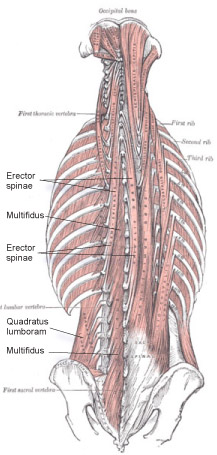
Some Posterior Trunk Muscles
The multifidus spinae muscle consists of a number of fleshy and tendinous fasciculi (bundles of skeletal muscle fibers surrounded by connective tissue), which fill up the groove on either side of the spinous processes of the vertebrae, from the sacrum all the way up to the axis (C2, the second cervical vertebra). The multifidus is a very thin muscle. It lies deep to the spinal erectors (erector spinae), transverse abdominus, and internal/external obliques. The fasciculi vary in length: the most superficial, which are also the longest, pass from one vertebra to the third or fourth above; those next in order run from one vertebra to the second or third above; the deepest connect two contiguous vertebrae. Together, they work to stabilize the vertebral joints at each segmental level, making each joint work more effectively, and reducing the degeneration of the joint structures.
We want to learn to be aware of our posture, improve it when needed, and increase our endurance and strength to maintain our optimal posture during all our activities.
The Role of the Pelvis
Gyandev: You mentioned pelvic stability. What is that, and where does it come from?
Barbara: Pelvic stability comes from the muscles of the front of the trunk working harmoniously with the muscles of the back of the trunk. For this discussion, it refers mostly to control of pelvic retroversion (tucking) and anteversion (tipping forward), although it can also mean side-to-side stability. Our general goal is to maintain a neutral spine during activity (including many asanas) to prevent excessive lumbar flexion or extension. Excessive or uncontrolled flexion or extension can create stress or compression in the spine, which can lead to pain.
Spinal Stability
Gyandev: How do we benefit from emphasizing spinal stability?
Barbara: Having the awareness and the strength to maintain spinal stability enhances the efficiency and effectiveness of all our bodily movements. If we’re going to move our arms or legs in any direction, it’s always more efficient to work off a stable spine. Just imagine moving your arms around when the spine is wobbling all over the place. Some of the strength of the limbs is literally lost when that happens.
This carries over into asana practice. The more spinal awareness and stability we have, the more we can progress — and the healthier our progress — in flexibility and strength of hips, shoulders, and so on.
Gyandev: Does “spinal stability” also entail a neutral spine?
Barbara: We want spinal stability in every position, even when we’re deliberately bending the spine, as in a backward bend. Often we’ll say, “Straighten your spine,” which is okay if students know that we mean “optimize your natural curves.” Having a neutral spine, and the strength to maintain it, both protects the spine and leads to optimal efficiency of limb function. That’s when we’ll recruit the right muscles to do our work. If your spine is wobbling or out of alignment, you’ll recruit the wrong muscles to compensate, and you’re likely to strain those muscles because you’re asking them to do things they’re not designed to do. This negatively impacts the alignment of all our joints; it also can cause wear and tear on the joint surfaces.
The goal isn’t to constantly have a straight spine; the goal is an uplifted, stable, and supple spine at all times. The position of the pelvis is very key in our goal of good posture, core strength, and spinal or trunk stability. The harmonized efforts of all the muscles on the front and back of the trunk helps to position the pelvis properly, and then stabilize and protect the spine.
Gyandev: So you take a “from the inside out” approach.
Barbara: Yes, that’s Ananda Yoga. It’s also my training as a physical therapist, although physical therapist training was purely on a physical level: head and trunk was control was a basic goal before optimal limb strength and function could be expected.
That’s also how we develop neurologically from birth: As infants, we first gain head control, then trunk awareness and control. We then gain control over our shoulders and hands. As we gain hip and leg strength, we crawl and then finally we walk.
And in a more subtle way, it works the same when healthy adults learn new activities such as yoga. We need a sense of stability in the spine in order to move our legs and arms effectively, and feel secure and be safe in our practice. It’s good to practice keeping a neutral, stable spine while we shift our weight in various directions. This can be done in Tadasana or “sitting Tadasana.”
It’s also true at the spiritual level: Learning to be gently aware of our spine physically — and then inwardly, on an energy level — helps us to be more balanced and stable. Both physically and spiritually we learn to respond to shifts and demands more gracefully and effectively if we are uplifted through and centered in the physical spine. Helping students learn that kind of awareness of the spine is helpful on all levels of life.
“Core Guidelines” for Teaching Yoga
Gyandev: How much do you think a yoga teacher needs to refer specifically to engaging core muscles, versus simply telling the body to keep an uplifted, neutral spine, and leave it to the body to engage where it needs to in order to accomplish that? If it’s sufficient simply to keep an uplifted, neutral spine, then our awareness is going to be freed up for subtler things that have more to do with energy and consciousness, and less to do with the physical body.
Barbara: You can take a lot of the fun — and depth — out of the postures by micromanagement. I feel that most people benefit from general cues: Lift up through the spine, tuck your pelvis, draw your navel toward the spine, and so on. Sometimes individual muscle focus is very helpful — when a person has weak muscles in some places, or an injury (even minor injuries can shut off certain muscles) — but that’s a therapeutic arena; it’s not what we’re talking about here. I feel that, for most people with healthy bodies, especially in Ananda Yoga where our focus is primarily on energy, we want the cues to be more general.
A lot of it takes care of itself when we think about lifting through the spine. However, I’m not saying there isn’t a place for more focused instruction from someone qualified. Our bodies and karma can be very complex, and an individual may need more attention drawn to a specific muscle group, but we don’t want to forget the whole person as we work on specific parts.
But most of the time, a lot will be gained from an emphasis on general good body mechanics and “good posture.”
Gyandev: When teachers say, “Engage your core as you enter the forward bend,” I wonder: “What will students engage when they hear that? The rectus abdominis?” That would tend to round the spine, which is not what we want at all.
Barbara: True, if students don’t know what that phrase means, they may assume that you’re referring to the abdominal muscles. That might lead them to think that a forward bend is about rounding the spine. In reality, the whole trunk should activate harmoniously, although the multifidus muscles on the back may be exerting the most effort in order to maintain a neutral spine and to keep the spine and pelvis together as a unit as we enter into the first phase of the pose.
I prefer to say, “Bend at the hips and keep the spine long and the front part of the body open, as you enter the first phase of your forward bend.” This allows us to lead with the heart and have a much fuller breath in the pose.
Another example is in standing backward bends: You don’t have a neutral spine in those, obviously, but neither do you want to “collapse” (excessively bend) the lumbar spine. The abdominals and multifidus have to work in harmony to help prevent such a collapse. The abdominals don’t just let go or get stretched; rather, they contract eccentrically to prevent the bend from going entirely into your lumbar spine. The contraction of the multifidus helps to lift the movement throughout the length of the spine, which opens the heart and also helps to prevent a collapse in the low back.
Gyandev: Can one learn to be aware of and engage the deeper back muscles in isolation?
Barbara: If you’re very still during the tensing and relaxing of the back muscles in the Energization Exercises you can sense those deeper muscles. At first, you may have to imagine that you feel them, or put your hands there and feel deep inside, but the awareness does come.
I don’t go into a lot of detail with individual muscles in teaching asanas, though, because I want people to get the feeling of the movements, not just intellectual information. Still, the deeper muscles of the trunk (e.g., the multifidus) are very important, because that’s where our refined movement comes from. The larger, more familiar muscles (e.g., the latissimus dorsi) are the heavy lifters, but some of the deeper muscles provide us with the endurance to have postural control throughout the day.
Muscles of the Pelvic Floor
Gyandev: Do the deep pelvic muscles [the perineal muscles, or “pelvic sling,” a complex of short muscles that criss-cross the floor of the pelvis] play a role in the core?
Barbara: Energetically, yes. If you’re in Warrior Pose and you’re sagging into it, those pelvic floor muscles may be sagging as well. We emphasize in Ananda Yoga lifting ourselves energetically and physically in our asana. When you level the pelvis and lift through the top of the head then everything can draw up, even though you’re not trying to engage the pelvic muscles — it can happen naturally because of what we’re doing with our energy.
I think that having appropriate tone in the pelvic floor has a physical and energetic benefit, but I rarely teach students to engage the pelvic floor except as an exercise in itself. Adding a contraction of the pelvic floor during asana might be confusing for a lot of people, and adversely affect attempts to breathe softly or work on alignment in other areas.
Of course, some people simply cannot feel anything down inside the pelvis, and they might need to consciously lift the pelvic floor a bit, to become more aware of those muscles and develop energy awareness. In time the energy focus will help that physical lift to happen automatically. But for most people, doing it consciously is confusing or unnecessary — or both.
I should add that, for all women, especially in menopause and aging students, toning the muscles of the pelvic floor is very important for maintaining urinary status, and a sense of vitality in that area. You want all areas of your body healthy and vital, regardless of your reproductive status. The pelvic floor provides support for the pelvic organs. So I have taught pelvic floor exercises, as a health measure, but I don’t emphasis it in asana practice.
Gyandev: So if one can keep the spine neutral, does one even need to emphasize the core at all?
Barbara: Although the core is very important, most students won’t need to be all that aware of its component parts. Rather, they will benefit from awareness of the trunk as a unit in itself, and the value of having that awareness to protect the spine and help draw the energy inward by feeling more centered in their body.
Helping Students Develop Stability
Gyandev: If you see someone wobbling in class as soon as she brings her arms overhead, what’s your first course of action?
Perhaps give her a gentle touch to bring her awareness to stability, or to straightness. Often that’s sufficient. Some times a verbal cue will do it.
Gyandev: And if that’s not enough …?
Barbara: Then perhaps she needs to build stability by increasing awareness and strength. You can do that in a step-by-step manner, starting with simple warm-ups. For example, making sure the shoulder joints have adequate flexibility. We can begin to explore spinal awareness in Tadasana (or “sitting Tadasana”) and adding movements of the arms while focusing on maintaining a stable (not rigid) spine.
Then comes the next step: standing poses. We can first focus on moving just the legs, and keeping a neutral (or nearly neutral) spine and stable trunk. Poses like Vrikasana, Standing Backward Bend, or Utkatasana — even Virabhadrasana II — can be done with the hands at the heart. Then we can gradually increase arm involvement. Poses like Trikonasana or Padahastasana can be done concentrating on neutral spine as it moves through space, and add arms later. As we add arms in Vrikasana or Standing Backward Bend, we also have to allow for the possibility that some people will have the hands a bit ahead of the body, because they don’t have enough shoulder flexibility to bring the hands directly overhead.
For more experienced students, you don’t need to break it down to this degree, but for beginners, or for people who have trouble with stability, it can be helpful to work on stability in stages like this.
Repetition can valuable part of building awareness of and strengthening a neutral spine. Do a certain group of postures frequently — refine them and listen to them. Yes, add new ones to your routine from time to time, because the body is challenged and strengthened by variety, but keep repeating that basic group. With repetition you’ll become more aware of core muscles as your awareness of yourself and the pose deepens.
Concluding Thoughts from Barbara
Gyandev: If you were to encapsulate everything you’ve said …
Barbara: Start with an awareness of a lift in the spine in simple moves, which is essentially trying to find your good posture. For most people this translates into more stability and an engagement of “core” muscles. Add to that an awareness of pelvic stability so you can maintain a neutral spine. Then keep the shoulder blades back and down for shoulder girdle stability.
All our movements from that point on should be done with an awareness of what the spine is doing. People have to be honest with themselves in knowing how far they should be moving their shoulders and hips, so they don’t compromise the stability and neutrality of the spine, because that comes first. Movement of shoulders and other joints comes after that.
Especially in a deeper practice, you can lose the essence of it if you’re spending all your time thinking about engaging different muscles. But I think it’s necessary to give enough cues to enhance people’s awareness of the spine, which will enable them to draw the energy up.
It’s really quite simple: Watch your spine. Don’t let it wiggle around. Breathe. And smile, because that brings fluidity and suppleness to your trunk and your entire being.
Alan on the Role of the Core
Gyandev: What is the core?
Alan: The “core” is the entire torso (upper body) whilst the extremities (the upper and lower limbs) rely upon the core for stabilization and force production. It is not simply the abdomen, as the abdomen is continuous with the thorax, etc. The body is always a whole, so the concept of the core is really an arbitrary one. It is a means to see and understand part of the whole in a better and clearer light. It’s problem when the core is treated in separation and isolation from the other parts of the body, assuming almost mythical status! It is simply part, not the whole picture. It is a way of describing how the torso functions for ease of understanding, and to see how important it is to work this area in a balanced way and integrate its functions with the rest of the body.
Gyandev: Most yoga teachers seem to speak about the core solely in terms of its role in stabilizing the torso, or spine. How do you see it?
Alan: In my experience, many people grab hold of a term, and see it in isolation from everything else. One structure may have a major role, such as stabilization, but also another part to play, such as in contributing to movement. We can isolate whatever body parts we want to, theoretically, but in reality the parts work together in a very synchronous manner, and this involves the intelligence to play more than one role. So I think of the core as an “action center” that has a number of very important functions, including:
- Protect the central nervous system and internal organs
- Support the internal organs and provide gentle mobilization of them through movement
- Improve circulation and the fluid dynamics (flow) through the organs
- Support the circulatory systems by helping to move blood and lymphatic fluid around the body
- Provide a strong, stable foundation for body movement, without which the spine and extremities would not function properly, which can predispose one to injury
If we view the core as having an inner unit and an outer unit, each having specific functions to perform, then we can see how balance of different layers of muscle groups is important for optimal function.
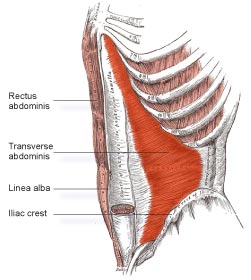
Transverse Abdominis
This view of the left anterior torso shows the rectus abdominis and transverse abdominis (TVA), the innermost of the flat muscles of the abdomen, just beneath the internal oblique muscle. The TVA helps to compress the ribs and viscera, providing thoracic spinal and pelvic stability. It has horizontal (i.e., transverse) fibers, running from our sides (anterior iliac crest, inguinal ligament, and bottom rib) to the front (where it merges with the linea alba and internal oblique). It also is connected to the diaphragm, which helps with inhalation.
The inner unit is about stability: It comprises the deep spinal muscles (multifidus), pelvic floor muscles, the deepest abdominal muscles (tranversus abdominis) and diaphragm (see illustrations here and above). The internal obliques and latissimus dorsi also assist the inner unit. The inner unit’s job is to stabilize the spinal column, rib cage and pelvic girdle so that the head, arms and legs have a strong, stable foundation from which to act. Stabilization begins in the inner unit muscles and progresses outward toward the periphery of the body.
The outer unit is about mobility: It consists of the muscles designed to move the body, such as rectus abdominis, internal and external obliques, and erector spinae (see illustration above). Think of the outer unit muscles being like the powerful engine in your car, whereas the inner unit muscles are the suspension system that holds everything together and prevents shock and stress from damaging structures.
In a balanced body, these functions support and supplement each other through coordinated action allowing for smooth, efficient, effective movement production throughout the entire body.
Differentiation vs. Integration
Gyandev: So the internal obliques belong to both units. That suggests that one cannot strictly differentiate between inner and outer core from the standpoint of which muscles one engages to perform certain activities (stabilizing or mobilizing)?
Alan: Strict differentiation is useful only for ease of understanding. Certainly top athletes and dancers do not know — or care — about the specific actions of muscles. But such knowledge can help a professional discover how to help an individual recover from an injury, or change an inappropriate movement pattern. Isolation is valuable only as a stepping-stone toward integration — and it is the integration of muscle action, ligament integrity, etc., that will produce healthy and efficient movement, or stability, or both.
I feel that the intention is what’s important. When we perform (or refrain from) a movement, we don’t need to think, “Well, I need to contract the transverse abdominis now, and then the multifidus, etc.” In fact we don’t even need to know the names of muscles in order for them to do their jobs. The body is so intelligent that it knows what to do and how to do it — if it is allowed to, that is, if it is guided by the intention, or thought, to do it. That thought will initiate the correct sequence of movements, the correct involvement of body parts.
The difficulty is, when it comes to performing a movement, some people do not know what they should be doing; they do not understand the desired outcome. For example, if you say to someone, “Stay stable now,” he or she may have no idea how to do it. This confused intention can lead to repetition of an incorrect movement. Eventually it becomes a deeply ingrained bad habit! So getting clear on what to do, and how to do it consciously, will lead to doing it unconsciously and correctly.
The Pelvic Floor
Gyandev: I suspect that most people can grasp the stabilizing role of, say, the multifidus more easily than that of the pelvic floor muscles. Can you explain their role?
Alan: The pelvic floor doesn’t attach directly to the spine, so it may not immediately be referred to as a spinal stabilizer. However, in its integrated function along with other muscles, it completes a “circle” that provides stability and support for the organs, both when the spine is stationary and when it is mobile.
Here’s how: I think of the pelvic floor as one of several “trampolines” in the body: one supports the brain, one the lungs, one the pelvic organs, and one the foot structures. They are “transverse tension membranes.” The pelvic floor muscles provide essential everyday support for the pelvic viscera (organs, e.g., uterus, intestines, bladder) and maintain the integrity of urinary and anal sphincter function. Like any trampoline, if the tension in the pelvic floor gets too loose, it will not function correctly, especially when exertion (through exercise or natural bodily functions) builds up pressure against the membrane.
Like everything in the body, the pelvic floor doesn’t work alone; it is part of a system. It is part of the “inner unit,” the muscles of which together form a closed framework for all the internal organs. By stabilizing the contents of the pelvis, the pelvic floor contributes to the overall stability of the larger “core” (not just the spine).
It’s like the foundation of a house: take it away and the walls begin to lose structural integrity. Then again, just having a strong foundation without strong walls is not helpful either. This is an example (theoretically, I suppose, but then it becomes very apparent practically to someone who suffers from a weak pelvic floor!) just how important it is for the body to function as a whole, with each part doing its job well. The whole is only as strong as the interaction of its parts, and the pelvic floor is definitely one of the parts.
One simple exercise to maintain its integrity is to attempt to stop the flow of urine during micturition (passing urine). Oddly enough, many women are given pelvic floor exercises in the supine position — I say “odd” because the pelvic floor needs to maintain adequate function mostly in the upright position!
The Core in Asana Practice and in Daily Life
Gyandev: What role does, or should, the core play in asana practice?
Alan: Asana practice is an ideal opportunity to focus on not only our physical movement, but also our control of that movement. Trying to connect our mind and body, our thoughts and emotions and experience of a pose, gives us a chance to feel what our body, including our core, is doing.
Asana practice provides us with all the movements we need for daily living, such as bending, twisting, balancing, bearing weight — and it challenges our conscious control of those movements. Daily life consists of these movements also, but are we controlling them? Often we are not attentive when lifting, bending etc.; we’re thinking about something else, which separates body and mind. In asana we have the chance to go within and control and experience our movement and become more aware of what we need to do, and how our thoughts and emotions affect it. It also requires balance; the core must have balanced development to play its role effectively.
In a sense, asana practice can take us more into our connection with daily life and activities, as it is the ideal preparation for the multitude of activities coming our way. It allows us to become unconsciously competent by ingraining movement patterns that are effective and efficient, so when we enter back into daily life activities our nervous system has already been challenged and prepared for the task.
In short, because of the many physical movements asanas require, the “core” has to adapt in positive ways (if practice is correct in terms of alignment and safety, etc.) to control how well we balance, move, stretch, bend, twist, etc. The core is important in yoga, Pilates, weight training, tennis, golf, swimming etc, just as it is in lifting, bending, twisting, farming, carrying the kids, carrying the boxes, carrying the rubbish out to the dustbin, etc. It’s just that we have more conscious time for ourselves during a yoga session!
Gyandev: You seem to be saying, “Make the movements of asana consciously and correctly, and your core will do what it needs to do to keep you safe — not only in asana practice, but in daily life.” That is very different from what one often hears: “Engage your core so that you can make the movements of asana safely.”
Alan: Yes!!! And some people learn best from verbal cues, some from visual cues, and others from tactile cues. But if students who learn best from tactile cues (or adjustment) never get any, but instead see only visual cues — i.e., the visual example of the teacher doing an asana perfectly — they may not understand what to do. They may think they are doing the same thing, but in fact they are doing something else that may not be appropriate.
So in our classes we have the opportunity to help students make their movements consciously and correctly, but only if we understand that they need different modes of instruction. Without clear understanding of what the “core” is, “Engage your core,” can mean a hundred different things to a hundred different people — none of which may be useful at all!
Gyandev: I often hear “Engage the core” without reference to why, or whether some parts of the core should be engaged more and others less. For example, when a teacher says, “Engage your core as you move into the forward bend,” are students being asked to engage everything in the abdominal region and lower back, plus perhaps the pelvic floor? And how vigorously should they engage in each region? There is so much room for misinterpretation, which can lead to students fighting against themselves — e.g., virtually strangling the breath, and, if they engage the rectus abdominis significantly, shortening and rounding the spine at a time when it should be kept long and straight.
Gyandev, it is so good to hear what you say! There are so many well-meaning instructions given, without even the slightest hint of real understanding of what is being said! — not only in yoga, but in all forms of exercise, which is why so many people get injured in exercise classes or gyms! In a forward bend, contracting the rectus abdominis can indeed be detrimental to performance of the movement.
So conscious movement is one thing, but conscious and correct movement is quite another. Concentrating on the movement performance (the intention and outcome) is far more appealing to me, than concentrating on the specific muscles involved in that movement. In fact, too much concern over specific muscles could create tension instead of ease of movement.
Concluding Thoughts from Alan
Gyandev: Any last thoughts you’d like to offer?
Alan: To be honest, I think the less the term “core” is used, the better, unless it is understood. Even then, just because the teacher understands it, doesn’t mean he or she can convey the concept to others — or even needs to. Focusing solely on one thing tends to exaggerate its importance, and that can lead to imbalance. For example, if people do only crunch situps, they develop the rectus abdominis to a point of imbalance that negatively affects the lower back. The hip flexors work in harmony with the trunk flexors, which work in harmony with the neck flexors. All these work in reciprocal harmony with the muscles on the opposite side of the body: the back muscles and erector spinae. There is a natural balance and harmony built into the body, which can be damaged through inappropriate practice.
I remember a tenet I once read: “It is better to spend years looking for the right teacher, than to spend years studying under the wrong teacher.” So it is with “teachings” about the core.
Julie on the Role of the Core
Gyandev: Gyandev: What is the core?
Julie: There’s a simple way to look at it, and a complicated way. In simple terms, it’s what Swami Kriyananda says about sitting in meditation: “Think of your strength as coming from your spine, not from your muscles.” So the core is that central sensation that lengthens you and gives you a sense of strength — not only when sitting in meditation, but even as you begin a forward folding movement.
A more complicated way to think of the core is to think of all the muscles involved: the pelvic floor, the upper thigh and hip, the buttocks, all of the abdominal and spinal muscles, and even the chest muscles into the neck and throat.
Gyandev: What does “engage the core” mean to you?
Julie: Engaging the core is, in its most basic, physical definition, to become aware of and use the core muscles of the trunk (as opposed to the extremities). By “using” these muscles, I mean words like lifting, lightly isometrically squeezing them, or energizing them to an “on” or lightly contracted state, rather than leaving them limp.
Gyandev: Why engage the core muscles?
Julie: To become aware of it, and once we have become consciously aware of it, to use it to anatomically align the central part of the body — the trunk. This makes possible the neutral positioning of the body: placing it in a state of balance between contraction and relaxation of the body’s muscle groups. The three main reasons why this is important are that it:
- Ensures safety in movement and activity for the trunk and especially the extremities
- Provides for maximized or optimum breathing capacity
- Strengthens the core muscles and promotes safe strengthening of the extremities as well
On a physical level, it’s important to move the body, with strength, from a central place, because that permits optimum function without injury. On a subtle level, it promotes body awareness and keeps us rooted in present-moment consciousness. I often counsel my chiropractic patients to do everything from their core: vacuum, unload the clothes dryer, lift groceries, perform sitting activities such as computer work. This promotes vitality, optimal alignment and muscle use, and an optimal breathing experience. It also allows for grace and beauty to become part of us, physically and mentally, and be expressed in our movements.”
“Get the feeling” vs. “muscle by muscle”
Gyandev: You’re saying, “Start from your center, knowing the feeling you want, and draw upon your body wisdom to make it happen,” rather than a more complex approach: “First I’ll engage this muscle, now that one, and so on.”
Julie: Right. That muscle-by-muscle approach is the worst. It’s like being in a straightjacket — and it’s not always understandable, either.
Gyandev: Is it realistic to ask the body simply to do whatever it needs to do to keep the spine straight, without thinking much about individual muscles?
Julie: Certainly with beginners or people who are weak in certain areas, the right body parts might not engage or be strong enough to do the job. They’ll need instruction, perhaps some strength training, and meanwhile a modification of the asana so their weaknesses don’t create problems. And if they’re hurting or weak somewhere, it’s difficult to convey what they’re supposed to feel. So the question becomes, What do I as the teacher have to do to make that happen?
Gyandev: And that would be…
Julie: Begin by teaching people what a neutral spine feels like. Until they know that, it’s just a long list of things they have to do and try to feel in the pose, and wonder whether they’re doing it right.
You wrote once in Awake & Ready [Autumn 2005] about a set of warm-ups to teach people to become more aware of their spine: doing cat/cow in different poses, such as wide-legged, in a chair, in a number of different positions, even supine before Bridge Pose, and asking: “What does it feel like to do that here? What is my spine doing?”
And to teach people about a neutral spine, you also wrote about working from Tadasana, asking students to imagine the spine to be the trunk of a young birch tree — very straight and vibrantly alive, but flexible — and make small movements with the trunk: left/right, forward/back, circling, always keeping a straight spine and asking students to notice various muscles engaging and disengaging to maintain that straightness. This would train them to feel the goal, rather than too much focus on individual muscles.
Getting Clear on Bandhas
Gyandev: Yes, I want students to know why: “Why are we doing what we’re doing: tuck here, tip there, engage here, relax there?”
Julie: And how would you answer that question?
Gyandev: To put the spine in whatever position you want it to be in — straight, usually — and give it appropriate support in that position.
Julie: Yes, and also because then your breathing is going to be open as well. If you don’t have a straight spine, your breathing won’t be free and easy.
I used to confuse the bandhas with keeping a straight spine, but now I understand that they’re for directing energy. To say “Engage your lower bandha” as a core mechanism is to use the word in the wrong way; bandhas aren’t about core muscles and a straight spine.
Gyandev: True. When bandhas get too physical, not nearly as much of the energy aspect will happen. Research has proved that the human mind can focus on only one thing at a time, so the question is: What is that one thing you’re going to do? If the spine is where you need to take care of business, then that one thing should be the spine.
Julie: Yes, it’s “the core of the core.” Yet when you’re trying to help people understand their own bodies, you have to start with the physical. If you say, “Feel your spine,” they’ll likely think, “What do you mean? I can’t do that.” So I ask them to focus on an activity that they can relate to. For example, if I want them to engage the perineum, I might say, “Pretend you’re holding back your urine.” You have them think of the spine as the thing that’s held up by that “pelvic sling” when they hold their urine. It’s a way to bring some of these concepts down to earth.
Where to Stay Engaged
Gyandev: Speaking of the pelvic floor, where does that fit in your view as a chiropractor?
Julie: Lifting the pelvic floor promotes awareness of the pelvis and its position, so you can find a neutral pelvis. If you lift the pelvic floor, you’ll bring the pelvis toward neutral alignment, which is a safety payoff.
Gyandev: If a student already has good pelvic alignment, is it okay to relax the pelvic floor?
Julie: Even for that student, lifting the pelvic floor has a purpose: to encourage energy to rise, giving you that upward sensation. I use that in many poses, especially standing poses. Ultimately, it’s an energy direction; it’s not a physical “tighten and hold it.” So lifting the pelvic floor is a little bit for pelvic position, and a lot for getting lift.
To me, there should always be a lifting when you walk or do an asana, as opposed to a complete letting go, or hanging on your ligaments. There’s never a total letting go in the asanas.
Gyandev: Other than in Savasana and Balasana, you can’t totally let go in other poses. The question is, where would you do well to let go, and where shouldn’t you let go? Most poses require some engagement just to hold the position. In addition, each pose has an “action” — a direction of unobservable movement, such as lifting through the legs and lengthening the spine in Trikonasana, or pressing arms, shoulders and head into the floor in Sarvangasana while lengthening up through the inner legs. In most poses, that action is both physical and energetic; in Savasana and Balasana, however, that action is totally energetic.
Julie: In most poses, I would also engage the pelvic floor as a means of vitalizing the pose, making it a posture instead of just a position.
Of course, many students aren’t as interested in these things as I am. They just want to do the pose and get on with it. But I think it’s important to keep the body engaged, using the body’s muscles around the central core.
As a chiropractor, a lot of my perspective on asana practice centers around safety, and it has developed that way in response to our culture’s use of asanas. A Pilates instructor will have a different view. As a yoga teacher and chiropractor, I think of the use of the core as an exercise in conscious awareness of the body as a beautifully functioning, dynamic whole for safety of all its parts. And as you become more aware, you use it to explore your postures and become better at them — within the bounds of safe posture.
Sometimes that may mean engaging the entire core. For example, I often see people flopping their cervical spines. I’ll tell them to lengthen the spine, but I’ll also say, “Engage the lower core strongly and lift through the top of the head.” It gives them a power point to think about. And when they get that, I’ll say, “Okay, now let go of any tightening or constricting, but hold the energy.”
Gyandev: And as you develop greater awareness and strength, as well as good asana mechanics, you’ll want to be more selective about what you engage. If you have the entire core engaged, then right away you cannot breathe fully.
Julie: Yes, you’ll constrict the breath. But from a chiropractic viewpoint, I err on the side of constricting, just for the sake of safety — even for people with healthy spines — until they develop biomechanically sound movement. Then later I address the issue of freer breathing.
I think many teachers don’t have the depth of this discussion of the core. They think in terms of strengthening core muscles, like in Pilates, which is fine if strengthening is what’s needed, but it’s not the ultimate aim of the practice. I think they boil down those concepts and bring them into yoga practice, which isn’t appropriate. The goals of Pilates and yoga are quite different.
Concluding Thoughts from Julie
As a chiropractor and yoga teacher, I feel that core training is valuable for postural alignment, safety, healthy breathing, and general strengthening. Above all, it can increase our awareness of our center, our spine, or core, helping us find and live from that inner place of peaceful strength.
I also feel that many yoga teachers overuse the phrase, “engage the core,” or use it incorrectly or not understandably. There are different dimensions of using the core:
- Becoming aware of it
- Breathing from it
- Lifting from it
- Operating from it
It’s not that we should always fully engage the entire core; sometimes it’s more in one area, less in another, depending on the pose and the person.
I believe it’s important that we as teachers know exactly what we’re trying to do, and convey that clearly to students. Perhaps the best beginning concept to teach might start with the intention of bringing students’ awareness to the center, core, or spine — and to help them imagine this place as their center of movement, breath, asana, and even meditation. That’s when their practice really becomes aligned with Ananda Yoga’s central principle of moving energy inward and upward to promote higher awareness.
Nicole on the Role of the Core
Gyandev: What do you see as “the core”?
Nicole: I see the core as several different things. It can refer to particular muscles in the trunk of the body. Another way to think about it is as the spine itself, since that’s our physical center and the starting point of our movements. On a more metaphysical level, it’s the astral (energy) spine. I’m careful when I mention the core in class, so it’s clear what I’m talking about.
The core has become very popular lately. People are eager to feel that they are strengthening their core, so I use the term more than I used to. It helps them open up their minds and feel good about their yoga practice.
But this doesn’t mean that I’m teaching differently now. I’ve always taught Ananda Yoga, but I may change my terminology in order to reach people where they are. If I have to say, “Engage your core” in order to engage them, fine. When they start to feel that upward lift, I can talk at subtler levels, and ask them to imagine they’re bringing that energy all the way up into the brain, refreshing the brain, making it more awake and alive. It’s just like when I’m teaching in a very secular environment: I’ll change my vocabulary to work with whoever my students are, to help them get the deepest experience they possibly can.
Core strength on a muscular level is very important, but it needn’t be a focus of the class. Certainly someone with weak core muscles may need to put more emphasis on strengthening the core to maintain health. They need to have enough “core strength” to, for example, get safely up into — and down out of — Sarvangasana. We used to say “abdominal muscles,” or “deep pelvic muscles” or “lower back”; well, now we say “the core.”
In past years, when teaching Parsvakonasana, I might have said, “Lift up out of your hips, and lengthen the spine.” Now I’ll say, “Make sure you’re engaging the core and not sagging into the hip sockets,” because that works for people today. But both approaches achieve the same effect.
Anyway, a good, well-rounded asana practice will strengthen the core automatically. Your core will be engaged if you’re careful about posture and alignment.
Gyandev: What about the subtler, nonphysical aspects?
Nicole: With Ananda Yoga, we want to bring energy up the spine, so having the concept of a physical core helps us get in tune with that subtle energy. If we’re not engaged, posturally speaking, then our spine is likely to be bent, and the energy won’t rise as easily. So we engage the core, and I say, “Feel as though you’re lifting that energy up the spine to the brain.” For some people, if you talk about energy in the spine right away, you lose them. But if you talk about core strength, you’ve got them hooked, because that’s what they want. Then they’re open to energy, and “inward and upward” feels more natural.
So constantly engaging the core is not the goal. It’s merely that the core should be engaged as appropriate in order to do what you want to do.
Gyandev: You mentioned abdominal muscles and deep pelvic muscles. What other muscles do you see as the core?
Nicole: Anything that keeps the spine upright, including the many muscles surrounding the spine, as well as the psoas. The abdominal muscles need to be lightly activated in order to be upright, because if you’re totally loose, the stomach sticks out and your lower back hyperextends. But you don’t want the abs contracted all the time, either; you want to be able to activate and release them at will.
This takes us back to the Energization Exercises, where you want to be able to send energy and activate those muscles at will, then relax them at will. You want them strong enough to do what they need to do, but you also want them to be able to relax. If you’re tensing your muscles all the time, you may be fatiguing them and setting yourself up for an injury. Say, if you’re holding tension there through the entire class, and at the end of it you want to lift up into a headstand, you might not be able to do it safely, because those muscles are spent. Even just picking up your yoga mat could be an opportunity for injury! So overworking muscles can give you the opposite effect from what you wanted.
It’s also about being healthy and in balance: We want to be just as able to let go and relax as to engage and hold. Being able to soften is an important skill; sometimes it’s harder than engaging. In some positions, core muscles are the very muscles we want to soften and let go, so they open up, lengthen and be stretched. That’s just as important as being able to contract.
Where Do We Really Engage?
Gyandev: Would you say that in some poses, perhaps in most poses, some parts of the core are engaged, but other parts are either relaxed or actually being stretched?
Nicole: That’s a good point. Because for example, in a backward bend like Chakrasana, you’re contracting the back muscles, but you’re stretching out the psoas and abdominal muscles, so they need to be released rather than engaged.
Gyandev: Some backward bends don’t need as much care in avoiding overextension. The easier forms of Salabhasana, for example, are mostly governed by strength through the back of the body, and overextension is rare. You might engage the abdominals slightly for balance, but not for protection.
Nicole: Right. In Salabhasana, those who do need to tuck the pelvis will engage the gluteal muscles, deep hip muscles, and deep pelvic muscles, then arc up and release the abdominal muscles in the front. So the protection comes from those muscles, not the abdominals.
Or in Bhujangasana, the protection may come from keeping the pelvis on the floor, not lifting higher. There, the abdominals can again stay relaxed, and once again, the gluteal muscles, deep hip muscles, and deep pelvic muscles take care of keeping the pelvis tucked to prevent excess lumbar extension. Abdominal contraction would mean just forcing the pose and creating tension, making the backward bend harder to do, but not really gaining anything, safety-wise, over contraction of the gluteal, deep hip, and deep pelvis muscles. The energy gets stuck in the abdomen, rather than flowing up the spine.
Speaking of backward bends, you want to have as much space as possible between vertebrae, so you’re not just jamming back. So if you tense everything to protect, and then you try to arch back, it’s not a long spine.
Gyandev: You mentioned the need for abdominal strength in Sarvangasana. Where would the abdominals be active in this pose?
Nicole: Mostly, it’s while going into and out of the pose from the supine position. You might hear people say that the abdominals protect the lower back in this pose, but lower back safety comes from lengthening up through the legs. If instead you let the legs be relaxed and heavy, no upward lift, you’ll compress the lower back regardless of what the abdominals do.
You might think that the abdominals should stay lightly contracted to prevent swayback, but in that position abdominal relaxation isn’t what would normally sway the back. The only thing is that, perhaps in trying to get your balance, you might press your pelvis forward and bring the legs back the opposite way, and that could compress the lumbar spine. In that case, you might need to engage the abdominals to correct this movement, but abdominal contraction is not inherent to the pose.
“Tensile force” is a term I’ve heard for that light abdominal contraction — even when you’re standing upright — so the internal organs don’t sag out and distort your posture. Just enough energy to keep everything where it belongs.
In fact, engaging the core in an attempt to avoid a problem can sometimes result in an overcorrection, creating a new problem. For example, if you contract your abdominals during inverted poses, you straighten out your lumbar curve — and constantly doing that can create just as many spinal problems as letting it sag into lordosis.
Strengthening the Core
Gyandev: Is there a place for intentional strengthening of the core?
Nicole: You have to look at who your students are. We’re not talking injuries here — therapeutic is another issue altogether — but healthy, sedentary people may need strengthening. For example, if you see people struggling with the poses, or they say things like, “Oh, I really felt that in my back,” and if you see it’s not a huge alignment issue, then you’ll want to incorporate some “core work.” It won’t be the emphasis of the entire class; simply insert one or two core strengtheners.
Also, if I am preparing students to do inversions, I will definitely insert a core strengthener, integrated with the breath, so the breathing pattern is very conscious. For example, supine leg lifts [exhaling and coming into a “tucked” pelvic tilt as they lift straight leg(s), hold the position and inhale, then exhaling as they lower the leg(s), then with both feet on the floor, releasing the tilt and inhaling], because that’s the motion that you need to lift into the pose. I used to say, “This is a good building block for the inverted pose we’re going to do.” Now I say, “This is a good core strengthener.” Same thing, different words.
Gyandev: What other core strengthening exercises might you have students do?

Nicole: For the deep pelvic and abdominal muscles, I might do variations on Navasana, the Boat Pose — not the V-pose from The Art and Science of Raja Yoga, because that engages more of the back muscles, but the “low boat”: legs and shoulder blades are barely off the floor, and the knees and eyes are at the same height. (See photo at right.)
I use some progressions for that, too. For example, if they have trouble coming off the floor from supine, I might have them sit upright and hold the knees, do a pelvic tilt (i.e., tuck the pelvis and draw the abdominal muscles inward), and lower the torso back down to the floor. Everyone would do this as a warm-up; then those who are strong enough could do the supine version, while the others stay upright. And there are other variations, such as staying upright and lifting one foot at a time, or one hand off the leg at a time, all in a progression.
Sometimes, the leg lift isn’t appropriate — it’s too much for them — so I might have them do a yogic sit-up.
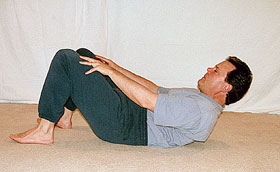
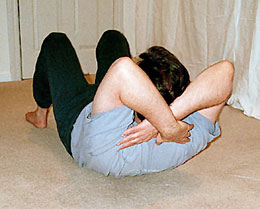
They lie down with knees bent, feet flat on the floor. They exhale as they come up — keeping the lower back on the floor throughout the exercise — and inhale as they come down. The hands are either on the thighs, with fingertips going no higher than the knees (see photo above left), or if that option creates an issue for the neck, they cross the arms behind the head and put their hands on opposite shoulders (see photo above right). They also can move from the former to the latter, since the neck may tire before the abdominals and deep pelvic muscles do.
Why call it “yogic”? First, because we’re moving with the natural rhythm of the breath, and trying to lengthen the breath, rather than just pumping out sit-ups, like you see in a gym. We don’t count them; we just do them for a period of a time. And I ask everyone to rest when the need to. That’s what makes it yogic: the focus on the breath, and we’re trying to slow the movements down, rather than seeing how many we can do in a given time interval.
Also, for people who are weaker and can’t do a full asana practice with all the different positions, it’s important to strengthen the transverse abdominals. For example, in a fuller class (as opposed to a very gentle practice, in which you might never get up off the floor) you’ll be upright a lot, and maybe twisting from an upright position, meaning those transverse muscles will need to activate. To prepare for that, we might do that same yogic sit-up with a slight twist in it, bringing one shoulder toward the opposite leg as you come up.
Concluding Thoughts from Nicole
I think that, in Ananda Yoga, the choice of asanas is less important than where the energy is going. You can lead a yoga class using one of the routines from The Art and Science of Raja Yoga, but if you’re not using the affirmations (or at best saying them without energy), and you’re moving mindlessly from one pose to the next, then you’re not really doing Ananda Yoga. On the other hand, you can lead a yoga class that primarily consists of strength poses for not only the core but for the extremities as well, and dynamically engage students with the affirmations, focus on the breath, and bring the energy inward and upward — and in my opinion, that would be teaching Ananda Yoga successfully.
I think that one proof of a successful Ananda Yoga class is when you have people who are not meditators, and feel they’re too restless even to try meditation, yet those people surprise themselves by enjoying the short meditation at the end of the class as much as the meditators do — and they keep coming back for more!
Core Concepts
Gyandev: I want to thank our panel of experts for giving so generously of their time, and for bringing such clarity to what I know has been a murky issue for many yoga teachers. To conclude, I’ll summarize what they’ve said in a five easy points:
-
The core” consists of a large collection of muscles that stabilize the spine and pelvis for safe and efficient movement. Very few people need to know the names of all those muscles.
-
Virtually all asanas — in fact, most significant movements and positions of the body — require engagement of some core muscles (the specific muscles vary from asana to asana), so it’s important to have sufficient strength in the core muscles.
On the other hand, a well balanced asana routine will naturally strengthen and train all the core muscles.
-
The instruction “Engage your core” should normally be avoided in yoga classes. For one thing, it’s much too broad: If students engage the entire core, they may end up fighting against their own bodies when they try to move — and even when they try to breathe!
Also, if “Engage your core” does not mean “Engage your entire core,” students may not understand which part(s) to engage and which to leave relaxed.
-
Instead, cultivate in your students an awareness of what the spine and pelvis are doing, as well as the ability to place the spine and pelvis in the desired alignment and support that alignment. Core muscles do this, of course, but it is wise simply to tell the body what to do, and let the body do what it needs to do to accomplish that without undue tension, rather than micromanaging via individual core muscles (e.g., “engage this one, relax that one”).
(Note: This article has been about healthy bodies; injuries or significant muscle weakness may require more specialized attention.)
-
In Ananda Yoga, the true core is the astral spine. All work with the physical core is about keeping the body physically safe and efficient, and the astral spine open and energized.
Happy practicing and teaching!
Learn More About Ananda Yoga
- Find a certified Ananda Yoga teacher near you
- Read about Ananda Yoga Teacher Training programs
All authors are graduates of Ananda Yoga Teacher Training.



